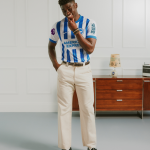
NBA players don't love the new City Editions jerseys
Kyle Kuzma's words best express what many people think
November 6th, 2023
For years, the NBA has focused its merchandising efforts on City Edition jerseys dedicated to the cities that are home to the 30 franchises of the world's premier basketball league. A trend, basketball jerseys (not just the city editions), that is becoming increasingly popular both in the US and in Europe, where the market favours football jerseys but has seen a boom in jerseys, preferably NBA jerseys, in recent years (also because very few European or Italian jerseys are produced and they are usually only available to buy in the shops of the respective team arenas). Tank tops have become a real item of clothing, so much so that they are worn in every situation: from going out with friends in the city to a night at the disco.
If the fans like them, the same can't be said for the players who wear these uniforms every other night on the floor across America. Some of them don't seem to like the direction the technical sponsor - Nike, which has dressed the league since the 2017-18 season - has taken in creating these very City Editions. A few weeks ago, one of basketball's most thoughtful and appreciated players for his style off the court, Kyle Kuzma, spoke out publicly. The Washington Wizards forward commented on the release of the City Editions of the Los Angeles Clippers, a team he doesn't play or has never played for, Nike ruins the nostalgia associated with jerseys: "Every year there's a new one and what's lost is the brand identity,' he commented on X (formerly Twitter). Nothing personal about the Clippers' choice, but a direct criticism of the Swoosh brand, against the proliferation of the many special editions which, according to him, move away from tradition.
What's wrong with the City Editions
The agreement between the NBA and Nike stipulates that each team can produce up to five different jerseys each year: 'Association", 'Icon", 'Statement", 'Classic" and 'City Edition". The latter were created to emphasise the relationship between the franchise and the city it belongs to through details and symbols that reveal hidden aspects. A narrative that is not always conveyed by the graphics, colours and style of the jerseys. Let's take a look at the jerseys for the 2023/24 season, for example, which were released just a few days ago. Take the Atlanta Hawks' jersey, for example, which departs from the usual colours (white, red and yellow) and instead features a jersey on a black background with white and blue edges; or the Houston Rockets' jersey, which is very plain apart from the lettering 'H-Town' and contains no reference to the city, the region of origin or the history of the corporate brand.
To conclude with the Clippers jersey mentioned by Kyle Kuzma: a dark grey background and only the word 'Clips' on the front. A tank top with no sense of belonging that can be described as 'heartless'. Not all jerseys are obviously disposable: Denver's, for example, with the classic Colorado mountain skyline, or Indiana's, which retains the colours with a touch of fantasy. Or the Cleveland Cavs one, designed by Daniel Arsham, the creative director of the Ohio franchise. However, one gets the sense that these types of jerseys are created in photocopy, with the sole purpose of filling calendar releases and saturating an already crowded market. Furthermore, Kuzma has no ties to Nike as he is sponsored by PUMA until 2024. So his words are absolutely free of contracts and communication rules and symptomatic of a league that has lost the cultural and stylistic relevance of a few years ago.
Has the NBA lost its modernity?
His words, in fact, follow those of another star of the league, Kevin Durant, who is instead a Nike man par excellence, so much so that he signed a lifetime contract last April. At the launch of his new shoe collection model, Ember Glow, KD addressed a cryptic message to the Beaverton-based company, explaining that they are simply shoes and nothing that will last forever. Nothing particularly serious, to be honest, but when a phrase like that is uttered by one of the league's most influential players and a Nike image maker for years. So Kuzma's appeal could be snubbed by Nike, but considering that the sentiment of several players seems to be heading in that direction, it's conceivable that the Beaverton-based brand will slightly revise its selection at the next opportunity and return to that tradition and nostalgia that KZ and the others don't want to lose along the way.
So it's no coincidence that the most popular jerseys of recent seasons have been those that feature a throwback design straight out of the late 90s or early 00s, the golden age of NBA basketball. From the Memphis Grizzlies in turquoise, to the Utah Jazz with their mountain ranges, to the Detroit Pistons or the Atlanta Hawks. At a time of strong revolution on the court, when new and exotic names dominate overseas, the NBA has not yet managed to find its new aesthetic and communicative dimension. Consider the lacklustre response to the design of the new courts for the in-season tournament, the league's latest attempt to give all franchises a unified profile. The NBA wants to reclaim the stylistic leadership role that football has taken away from it in recent seasons thanks to the block-core explosion, but it has yet to figure out how to do it.












